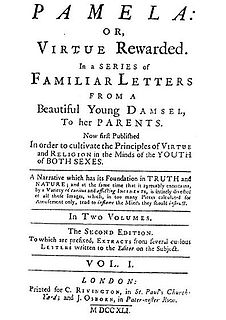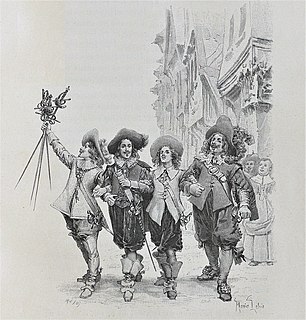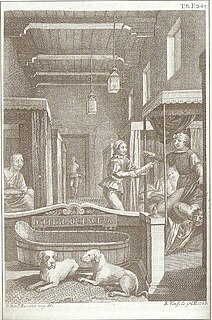Related Research Articles

Afonso IV, called the Brave, was King of Portugal from 1325 until his death in 1357. He was the only legitimate son of King Denis of Portugal and Elizabeth of Aragon.

An epistolary novel is a novel written as a series of documents. The usual form is letters, although diary entries, newspaper clippings and other documents are sometimes used, as are electronic documents such as recordings and radio, blogs, and e-mails. The word epistolary is derived from Latin from the Greek word ἐπιστολή epistolē, meaning a letter. In German, this type of novel is known as a Briefroman.

Worlds' End (1994) is the eighth collection of issues in the DC Comics series The Sandman. It was written by Neil Gaiman; illustrated by Michael Allred, Gary Amaro, Mark Buckingham, Dick Giordano, Tony Harris, Steve Leialoha, Vince Locke, Shea Anton Pensa, Alec Stevens, Bryan Talbot, John Watkiss, and Michael Zulli; colored by Danny Vozzo; and lettered by Todd Klein. The stories in the collection first appeared in 1993. The collection first appeared in paperback and hardback editions in 1994 with an introduction by Stephen King. The collection's title, setting, and a number of its themes and images are also found in G.K. Chesterton's poem "A Child of the Snows".

The Three Musketeers is a French historical adventure novel written in 1844 by French author Alexandre Dumas. It is in the swashbuckler genre, which has heroic, chivalrous swordsmen who fight for justice.
This article contains information about the literary events and publications of 1696.
A frame story is a literary technique that serves as a companion piece to a story within a story, where an introductory or main narrative sets the stage either for a more emphasized second narrative or for a set of shorter stories. The frame story leads readers from a first story into one or more other stories within it. The frame story may also be used to inform readers about aspects of the secondary narrative(s) that may otherwise be hard to understand. This should not be confused with narrative structure.

Oroonoko: or, the Royal Slave is a short work of prose fiction by Aphra Behn (1640–1689), published in 1688 by William Canning and reissued with two other fictions later that year. It was also adapted into a play. The eponymous hero is an African prince from Coramantien who is tricked into slavery and sold to European colonists in Surinam where he meets the narrator. Behn's text is a first-person account of Oroonoko's life, love, rebellion, and execution. Oroonoko: or, the Royal Slave “centers on the unlucky love story of Oroonoko, an African prince, and the beautiful Imoinda.”

The Duchess of Malfi is a Jacobean revenge tragedy written by English dramatist John Webster in 1612–1613. It was first performed privately at the Blackfriars Theatre, then later to a larger audience at The Globe, in 1613–1614.
Mathilda, or Matilda, is the second long work of fiction of Mary Shelley, written between August 1819 and February 1820 and first published posthumously in 1959. It deals with common Romantic themes of incest and suicide. The narrative deals with a father's incestuous love for his daughter.

Delarivier "Delia" Manley was an English author, playwright, and political pamphleteer. Manley is sometimes referred to, with Aphra Behn and Eliza Haywood, as one of "the fair triumvirate of wit", which is a later attribution.

Pamela; or, Virtue Rewarded is an epistolary novel first published in 1740 by English writer Samuel Richardson. Considered one of the first true English novels, it serves as Richardson's version of conduct literature about marriage. Pamela tells the story of a fifteen-year-old maidservant named Pamela Andrews, whose employer, Mr. B, a wealthy landowner, makes unwanted and inappropriate advances towards her after the death of his mother. Pamela strives to reconcile her strong religious training with her desire for the approval of her employer in a series of letters and, later in the novel, journal entries all addressed to her impoverished parents. After various unsuccessful attempts at seduction, a series of sexual assaults, and an extended period of kidnapping, the rakish Mr. B eventually reforms and makes Pamela a sincere proposal of marriage. In the novel's second part Pamela marries Mr. B and tries to acclimatise to her new position in upper-class society. The full title, Pamela; or, Virtue Rewarded, makes plain Richardson's moral purpose. A best-seller of its time, Pamela was widely read but was also criticised for its perceived licentiousness and disregard for class barriers. Furthermore, Pamela was an early commentary on domestic violence and brought into question the dynamic line between male aggression and a contemporary view of love. Moreover, Pamela, despite the controversies, was able to shed light on social issues that transcended the novel for the time such as gender roles, early false-imprisonment, and class barriers present in the eighteenth century. The action of the novel is told through letters and journal entries from Pamela to her parents. Richardson highlights a theme of naivety, illustrated through the eyes of Pamela. Richardson paints Pamela herself as innocent and meek to further contribute to the theme of her being short-sighted to emphasize the ideas of childhood innocence and naivety.

Mary Pix was an English novelist and playwright. As an admirer of Aphra Behn and colleague of Susanna Centlivre, Pix has been called "a link between women writers of the Restoration and Augustan periods".
Philippine literature in Spanish is a body of literature made by Filipino writers in the Spanish language. Today, this corpus is the third largest in the whole corpus of Philippine literature. It is slightly larger than the Philippine literature in the vernacular languages. However, because of the very few additions to it in the past 30 years, it is expected that the former will soon overtake its rank.
Alison Weir is a British author and public historian. She primarily writes about the history of English royal women and families, in the form of biographies that explore their historical setting. She has also written numerous works of historical fiction.

Wolf Hall is a 2009 historical novel by English author Hilary Mantel, published by Fourth Estate, named after the Seymour family's seat of Wolfhall, or Wulfhall, in Wiltshire. Set in the period from 1500 to 1535, Wolf Hall is a sympathetic fictionalised biography documenting the rapid rise to power of Thomas Cromwell in the court of Henry VIII through to the death of Sir Thomas More. The novel won both the Man Booker Prize and the National Book Critics Circle Award. In 2012, The Observer named it as one of "The 10 best historical novels".

Love in a Fallen City (傾城之戀) is a 1943 Chinese-language novel by Eileen Chang. It is also the first collection in English of the work of Eileen Chang, whom Ang Lee has called "the fallen angel of Chinese literature", the book is an original title in the NYRB "Classics" series.

The San Carlos Palace, is a 16th-century Neoclassical mansion in Bogotá, Colombia. Located on the corner of Calle 10 and Carrera 5, the historic building has been the site of various political, social and academic events. Since December 1993, it has been home to the Ministry of Foreign Affairs.
Battles in the Desert, or Las batallas en el desierto, is a novella written by Mexican author José Emilio Pacheco. The novella was first published in the Saturday edition of the Uno Más Uno, a Mexican newspaper, on June 7, 1980, but was published by Era the following year. The story is narrated by Carlos, as an adult, recounting his memories as a boy growing up in Mexico City in the late 1940s and 1950s. In particular, his experiences and the events that unfolded after falling in love with one of his classmate's mother comprise the central narrative of the short novel.

"The Dialogue of the Dogs" is a short story originating from the fantasy world of Ensign Campuzano, a character from another short story, The Deceitful Marriage. Both are written by author Miguel de Cervantes. It was originally published in a 1613 collection of novellas called Novelas ejemplares.
Elizabeth Marsh (1735–1785) was an Englishwoman who was held captive in Morocco for a brief period after the ship she was traveling from Gibraltar to England to unite with her fiancé was intercepted by a Moroccan corsair and overtaken by its crew. Marsh revealed the experiences of her captivity through her captive narrative,The Female Captive: A Narrative of Fact Which Happened in Barbary in the Year 1756, Written by Herself, published more than a decade after her return from captivity. The Female Captive documents Marsh's misfortunes after she and her shipmates were captured by Moroccan sailors, becoming the first captive barbary narrative written in English by a woman author. In the published version, Marsh also added quite a few details that helped reframe her narrative in a more novelistic form and that heightened the sense of danger she felt as well as created dramatic tension around the question of whether or not she would escape. Marsh's narrative is an important contributor to the larger genre of European women's captivity narratives, which frequently featured female resistance to captivity and sexual violence.
References
- 1 2 Day, Gary; Lynch, Jack (eds.). The encyclopedia of British literature, 1660-1789. p. 893. ISBN 9781118607268. OCLC 965475332.
- 1 2 Villegas López, Sonia (2003). Narrative levels in The Inhumane Cardinal (1696) by Mary Pix. Sociedad Hispano-Portuguesa de Estudios Renacentistas Ingleses= Sociedade Hispano-Portuguesa de Estudos Renascentistas Ingleses = Spanish and Portuguese Society for English Renaissance Studies. OCLC 800704657.
- ↑ Moore, Steven, 1951-. The novel : an alternative history, 1600-1800. ISBN 9781441188694. OCLC 835951204.
{{cite book}}: CS1 maint: multiple names: authors list (link)